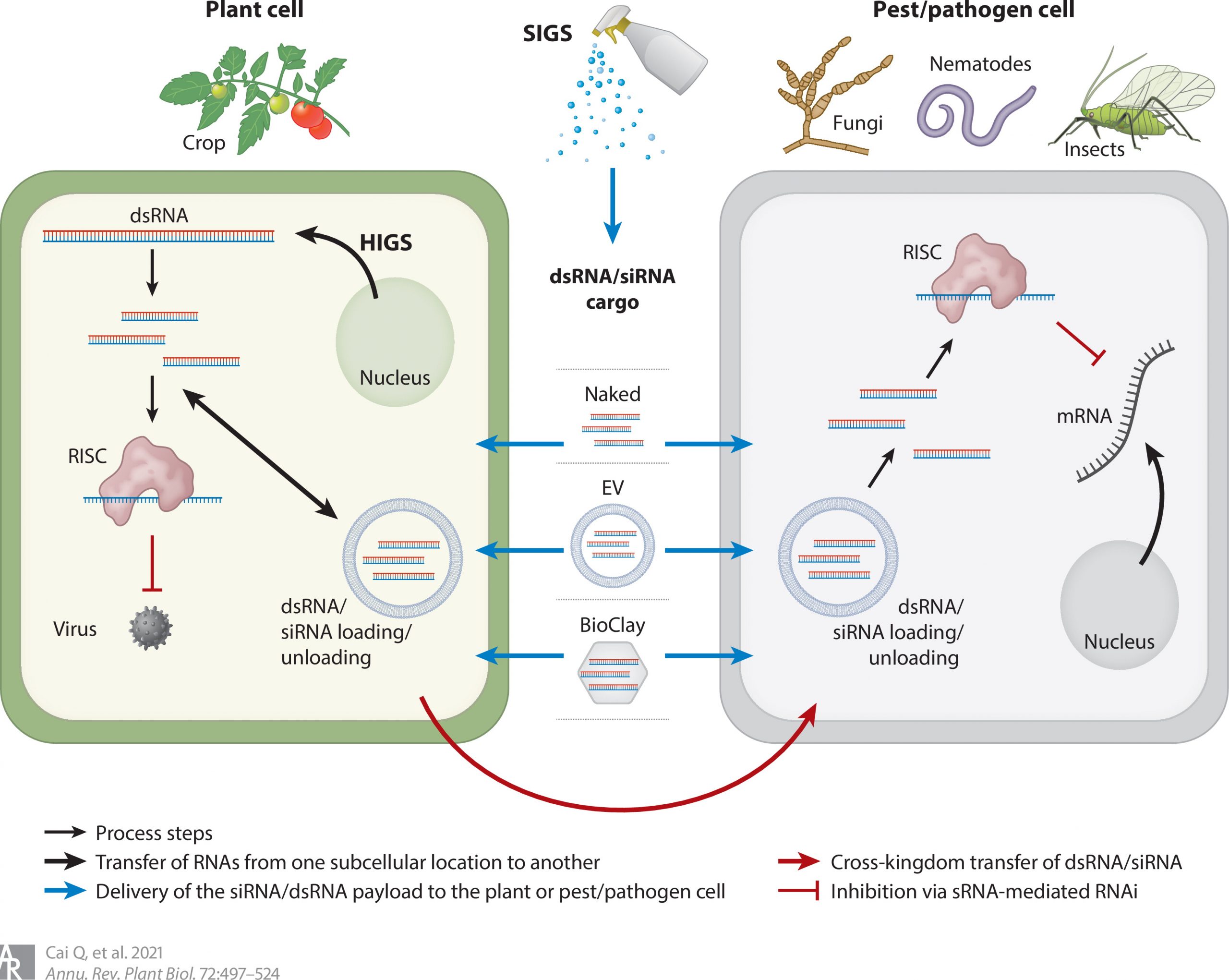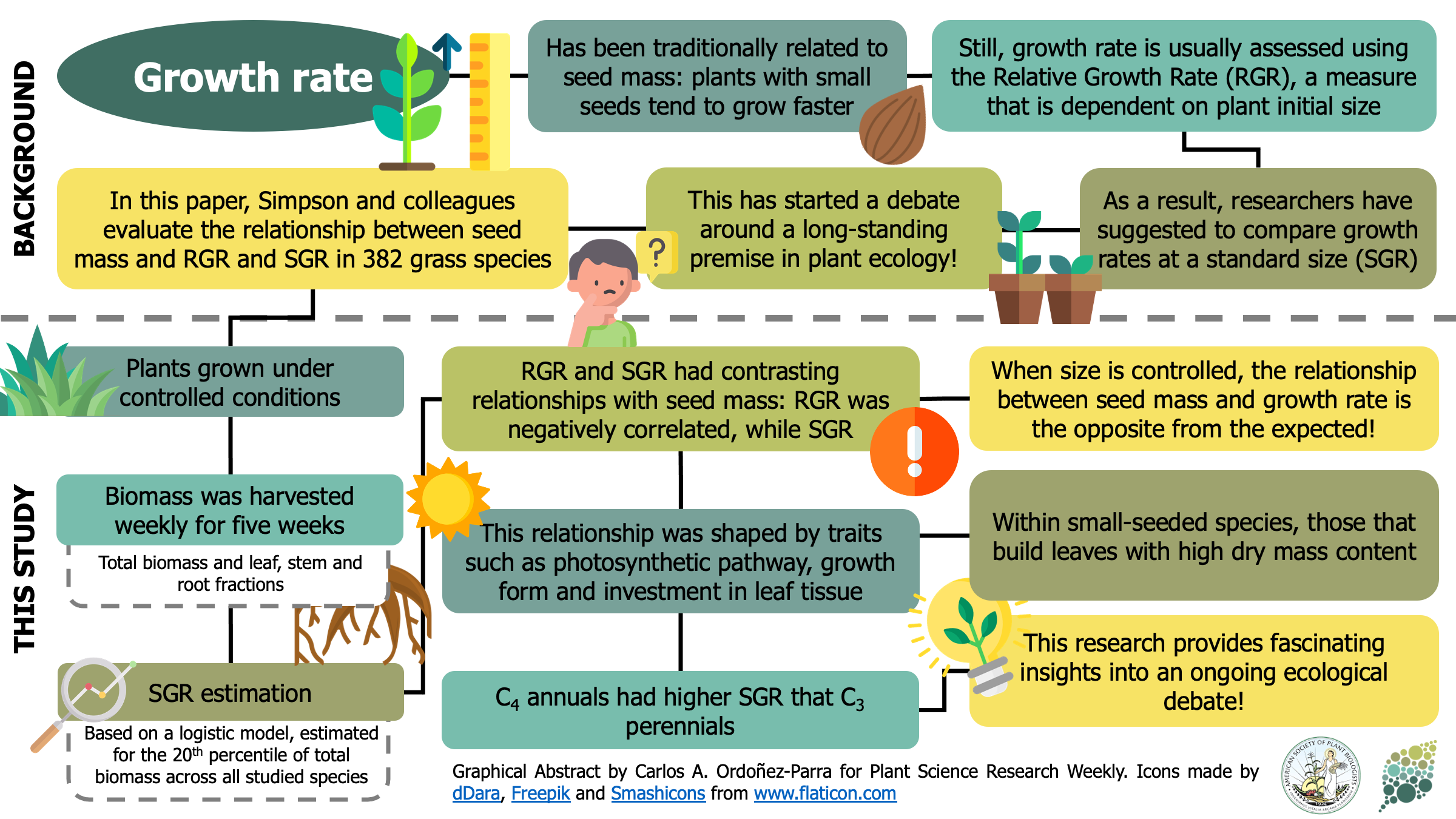Plant Science Research Weekly: July 16, 2021
Review. Message in a Bubble: Shuttling small RNAs and proteins between cells and interacting organisms using extracellular vesicles

Small RNAs have big effects and can serve to shut down or silence gene expression. Recently, studies have found that small RNAs can contribute to plant defense beyond the boundary of the plant, by being packed into extracellular vesicles (EVs) and delivered to a pathogen. Cai et al. review our current knowledge of small RNAs and proteins that shuttle between organisms. Isolation of EVs in extracellular fluids, through differential centrifugation or capture using an EV-specific antibody, facilitates analysis of their cargo. This review focuses on the formation of EVs and their roles in plant-microbe interactions, involving EVs derived from plants or their partners. A particularly interesting application of this work stems from the ability to engineer spray-on small RNAs as a form of crop protection. (Summary by Mary Williams @PlantTeaching) Annu. Rev. Plant Biol. 10.1146/annurev-arplant-081720-010616
Review. Plant synthetic biology for producing potent phyto-antimicrobials to combat antimicrobial resistance
 Covid has turned our focus to human viral pathogens, but the challenges we face from cellular pathogens has not gone away, and is increasingly exacerbated by the development of resistance to antibiotics and other antimicrobials. This fine review by Tiwari et al. provides an overview of how antimicrobials work and mechanisms of resistance, sources of natural antimicrobials with a focus on those from plants, and the application of synthetic biology to expand our toolkit of phyto-antimicrobials. This review provides examples of many specialized metabolites with altered production through plant chassis (as an example, production of the anti-malarial Artemisinin in Nitocotiana tabacum). It also highlights anti-microbial peptides that have been produced in plants, and results from gene editing in plants to manipulate metabolite production. This comprehensive review will introduce any scientist, not only plant biologists, to the potential of plant synthetic biology. (Summary by Mary Williams @PlantTeaching) Biotechnol. Adv. 10.1016/j.biotechadv.2021.107729 Want to learn more about plant synthetic biology? Check out the upcoming Plant Synthetic Biology conference (virtual) Sept 25-27, 2021.
Covid has turned our focus to human viral pathogens, but the challenges we face from cellular pathogens has not gone away, and is increasingly exacerbated by the development of resistance to antibiotics and other antimicrobials. This fine review by Tiwari et al. provides an overview of how antimicrobials work and mechanisms of resistance, sources of natural antimicrobials with a focus on those from plants, and the application of synthetic biology to expand our toolkit of phyto-antimicrobials. This review provides examples of many specialized metabolites with altered production through plant chassis (as an example, production of the anti-malarial Artemisinin in Nitocotiana tabacum). It also highlights anti-microbial peptides that have been produced in plants, and results from gene editing in plants to manipulate metabolite production. This comprehensive review will introduce any scientist, not only plant biologists, to the potential of plant synthetic biology. (Summary by Mary Williams @PlantTeaching) Biotechnol. Adv. 10.1016/j.biotechadv.2021.107729 Want to learn more about plant synthetic biology? Check out the upcoming Plant Synthetic Biology conference (virtual) Sept 25-27, 2021.
PIFs link environmental changes with chromatin dynamics
 PHYTOCHROME INTERACTING FACTORS (PIFs) play a pivotal role in mediating the responses of plants to various environmental stimuli. Although the importance of PIFs in shade avoidance response is well known, the relative contributions of different PIFs have not been discretely determined. In a recent study, Willige et al. identified that among the PIFs, PIF7 acts as the predominant regulator of seedling growth changes in response to low R:FR light that simulate shade. Using a genome-wide approach, the authors found that PIF7 is rapidly dephosphorylated and released from photobodies under low R:FR, and directly activates numerous transcription factor genes, initiating a complex network that results in widespread gene expression changes. Interestingly, the activation of various genes under low R:FR is closely associated with a dynamic and reversible reduction in the histone variant H2A.Z and an increase in the lysine-9-acetlylated histone H3, which are gene repression and activation marks in the chromatin, respectively. The removal of H2A.Z is mediated by a highly conserved SWI/SNF chromatin remodeler complex named INO80. PIFs promote H2A.Z eviction under low R:FR by interacting with EIN6 ENHANCER (EEN), one of the subunits of INO80. The authors end the study by speculating the possible role of PIF-INO80 module in other environmental responses such as thermomorphogenesis, which has subsequently been demonstrated by Xue et al (2021). (Summary by Yadukrishnan Premachandran @yadukrishprem) Nature Genetics 10.1038/s41588-021-00882-3
PHYTOCHROME INTERACTING FACTORS (PIFs) play a pivotal role in mediating the responses of plants to various environmental stimuli. Although the importance of PIFs in shade avoidance response is well known, the relative contributions of different PIFs have not been discretely determined. In a recent study, Willige et al. identified that among the PIFs, PIF7 acts as the predominant regulator of seedling growth changes in response to low R:FR light that simulate shade. Using a genome-wide approach, the authors found that PIF7 is rapidly dephosphorylated and released from photobodies under low R:FR, and directly activates numerous transcription factor genes, initiating a complex network that results in widespread gene expression changes. Interestingly, the activation of various genes under low R:FR is closely associated with a dynamic and reversible reduction in the histone variant H2A.Z and an increase in the lysine-9-acetlylated histone H3, which are gene repression and activation marks in the chromatin, respectively. The removal of H2A.Z is mediated by a highly conserved SWI/SNF chromatin remodeler complex named INO80. PIFs promote H2A.Z eviction under low R:FR by interacting with EIN6 ENHANCER (EEN), one of the subunits of INO80. The authors end the study by speculating the possible role of PIF-INO80 module in other environmental responses such as thermomorphogenesis, which has subsequently been demonstrated by Xue et al (2021). (Summary by Yadukrishnan Premachandran @yadukrishprem) Nature Genetics 10.1038/s41588-021-00882-3
Large seeds provide intrinsic growth advantage that depends on leaf traits and root allocation
 A long-standing premise in plant ecology is that seed mass and growth rate are negatively correlated, meaning that small-seeded species grow faster than large-seeded ones. However, this relationship remains controversial given that the most common measurement for growth rate –Relative Growth Rate (RGR)– is dependent on plant size. Since this dependency makes it difficult to compare plants with different initial (seed) sizes, different authors have suggested comparing species growth rates by fitting models that estimate RGR at a standard size (SGR). Here, Simpson and colleagues assess the relationship between seed mass and RGR and SGR in 382 grass species. Moreover, they evaluate whether this relationship is shaped by species ecology, phylogeny or other traits. RGR and SGR hold contrasting relationships with seed mass: while RGR was negatively correlated, SGR had a positive relationship, meaning that when size is controlled, species with large seeds grew faster. Moreover, this relationship was influenced by other traits like the photosynthetic pathway, growth form and investment in leaf tissue. As a result, this study provides fascinating insights into an ongoing ecological debate and becomes an obligate reading for future research about the functional importance of seed mass (Summary by Carlos A. Ordóñez-Parra @caordonezparra) Funct. Ecol. 10.1111/1365-2435.13871
A long-standing premise in plant ecology is that seed mass and growth rate are negatively correlated, meaning that small-seeded species grow faster than large-seeded ones. However, this relationship remains controversial given that the most common measurement for growth rate –Relative Growth Rate (RGR)– is dependent on plant size. Since this dependency makes it difficult to compare plants with different initial (seed) sizes, different authors have suggested comparing species growth rates by fitting models that estimate RGR at a standard size (SGR). Here, Simpson and colleagues assess the relationship between seed mass and RGR and SGR in 382 grass species. Moreover, they evaluate whether this relationship is shaped by species ecology, phylogeny or other traits. RGR and SGR hold contrasting relationships with seed mass: while RGR was negatively correlated, SGR had a positive relationship, meaning that when size is controlled, species with large seeds grew faster. Moreover, this relationship was influenced by other traits like the photosynthetic pathway, growth form and investment in leaf tissue. As a result, this study provides fascinating insights into an ongoing ecological debate and becomes an obligate reading for future research about the functional importance of seed mass (Summary by Carlos A. Ordóñez-Parra @caordonezparra) Funct. Ecol. 10.1111/1365-2435.13871
When mentoring matters: a French mentoring program for women in science
 The term gender scissor describes the distribution of men and women throughout their scientific career: while girls represent more than a half of the University students, the percentage of women in science markedly decreases beyond the PhD. This trend has been reported in different European Union member states including France. In this country, female scientists are underrepresented not only in academia but also in private companies, where they reach only 20% of all researchers. Different studies suggest that lack of support and scarcity of role models could be among the causes underlying this imbalance. Batut and colleagues report an innovative mentoring program aimed at supporting and guiding young female students during their PhD in French institutions. This program lasts 12 months and encompasses three main activities: First, one to one meeting between a mentor and a mentee (ideally face to face once a month). Second, discussion group meetings between mentoring circles about specific issues such as work/life balance and self-confidence. Third, testimonies of established female scientists and career development workshops. The mentoring program started in Montpellier six years ago with only 15 mentor-mentee pairs. Since then, it has increased in participants and expanded to other French universities, thanks to the work of “Femme & Sciences” (https://www.femmesetsciences.fr/), who also monitor its progresses through follow-up of meetings and final evaluation surveys. To date, the majority of early career female scientists who have participated in the program have a scientific position in academia or industry. In the long-term, the goal of the program is to increase the number of women in science and to cut the gender scissor. (Summary and wordcloud by Michela Osnato @michela_osnato) Nature Biotechnol. 10.1038/s41587-021-00951-2
The term gender scissor describes the distribution of men and women throughout their scientific career: while girls represent more than a half of the University students, the percentage of women in science markedly decreases beyond the PhD. This trend has been reported in different European Union member states including France. In this country, female scientists are underrepresented not only in academia but also in private companies, where they reach only 20% of all researchers. Different studies suggest that lack of support and scarcity of role models could be among the causes underlying this imbalance. Batut and colleagues report an innovative mentoring program aimed at supporting and guiding young female students during their PhD in French institutions. This program lasts 12 months and encompasses three main activities: First, one to one meeting between a mentor and a mentee (ideally face to face once a month). Second, discussion group meetings between mentoring circles about specific issues such as work/life balance and self-confidence. Third, testimonies of established female scientists and career development workshops. The mentoring program started in Montpellier six years ago with only 15 mentor-mentee pairs. Since then, it has increased in participants and expanded to other French universities, thanks to the work of “Femme & Sciences” (https://www.femmesetsciences.fr/), who also monitor its progresses through follow-up of meetings and final evaluation surveys. To date, the majority of early career female scientists who have participated in the program have a scientific position in academia or industry. In the long-term, the goal of the program is to increase the number of women in science and to cut the gender scissor. (Summary and wordcloud by Michela Osnato @michela_osnato) Nature Biotechnol. 10.1038/s41587-021-00951-2
The Plant Cell is accepting applications for Assistant Features Editors

The Plant Cell is accepting applications for new Assistant Features Editors (AFEs) for 2022. AFEs provide a valuable service to the journal, our authors, and the scientific community. In return, AFEs join our editorial board and receive training and experience in writing and communicating scientific findings to a wide audience, as well as networking opportunities and editor training through participating in activities of The Plant Cell editorial board. We are welcoming applications through Monday, September 27, 2021. Read more https://plantae.org/call-for-tpc-afes/.



